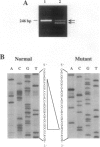Abstract
Renal-coloboma syndrome is a recently described autosomal dominant syndrome of abnormal optic nerve and renal development. Two families have been reported with renal-coloboma syndrome and mutations of the PAX2 gene. The PAX2 gene, which encodes a DNA-binding protein, is expressed in the developing ear, CNS, eye, and urogenital tract. Ocular and/or renal abnormalities have been consistently noted in the five reports of patients with renal-coloboma syndrome, to date, but PAX2 expression patterns suggest that auditory and CNS abnormalities may be additional features of renal-coloboma syndrome. To determine whether additional clinical features are associated with PAX2 mutations, we have used PCR-SSCP to identify PAX2 gene mutations in patients. We report here four patients with mutations in exon 2, one of whom has severe ocular and renal disease, microcephaly, and retardation, and another who has ocular and renal disease with high-frequency hearing loss. Unexpectedly, extreme variability in clinical presentation was observed between a mother, her son, and an unrelated patient, all of whom had the same PAX2 mutation as previously described in two siblings with renal-coloboma syndrome. These results suggest that a sequence of seven Gs in PAX2 exon 2 may be particularly prone to mutation.
Full text
PDF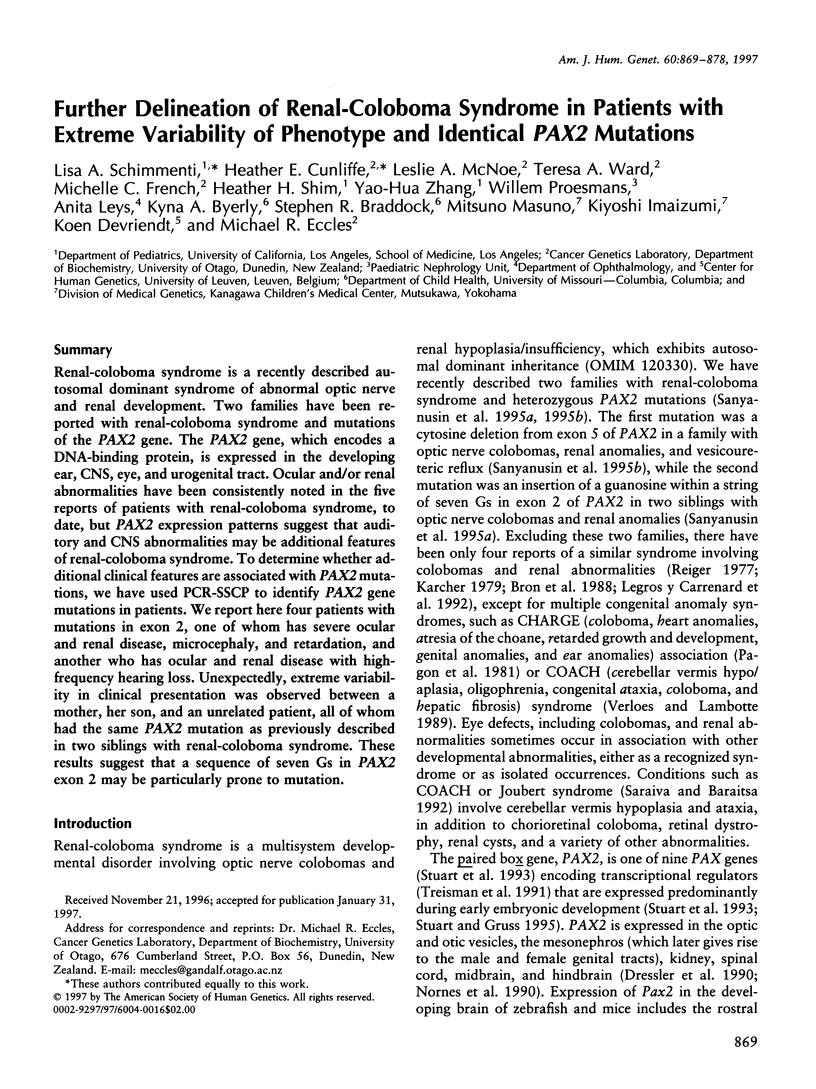
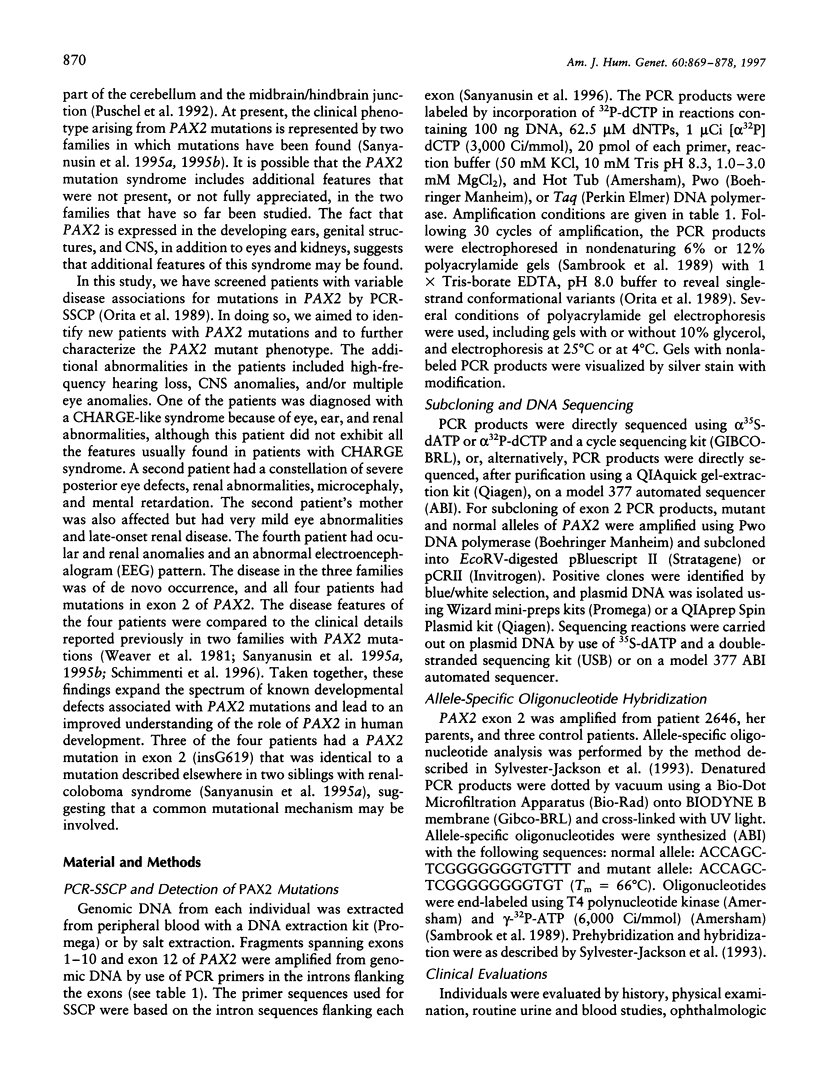
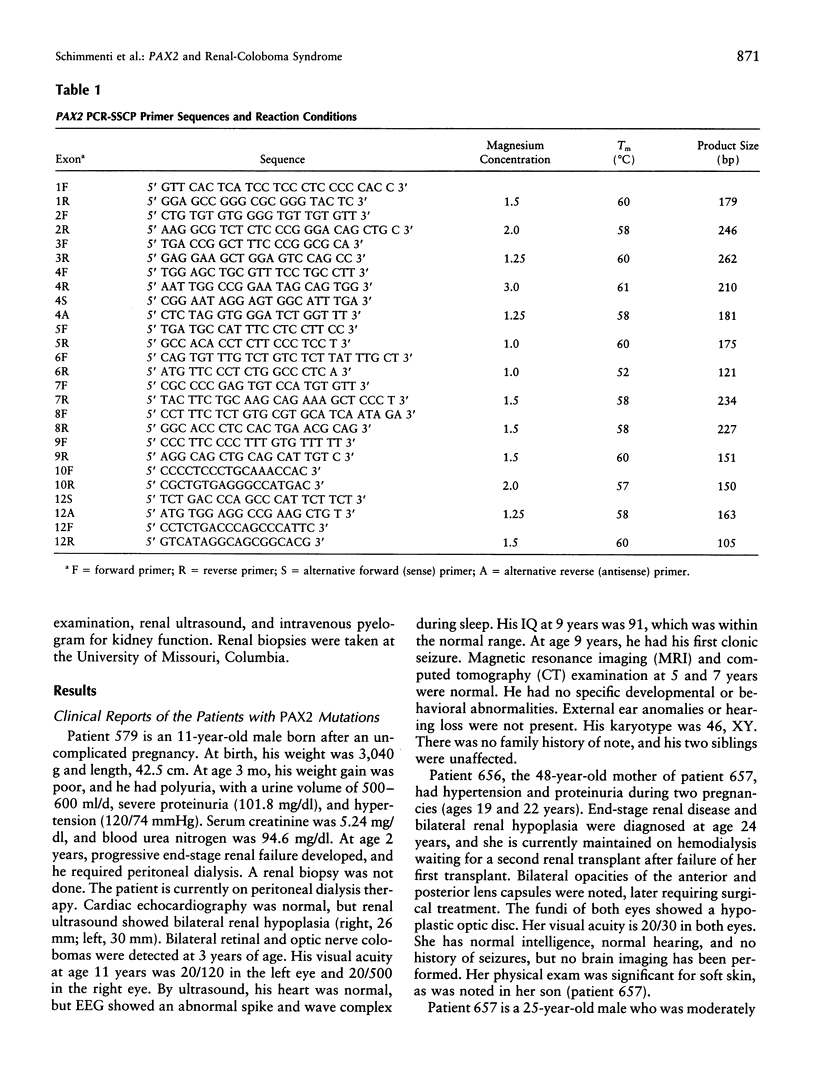
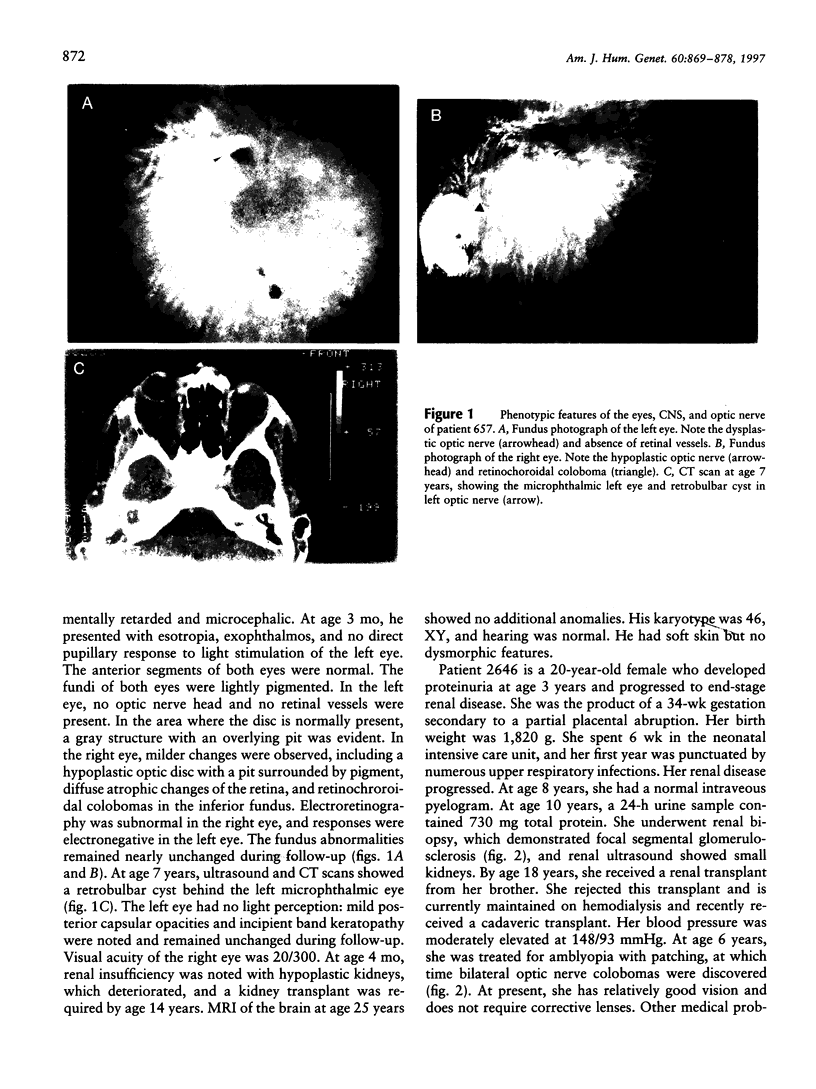
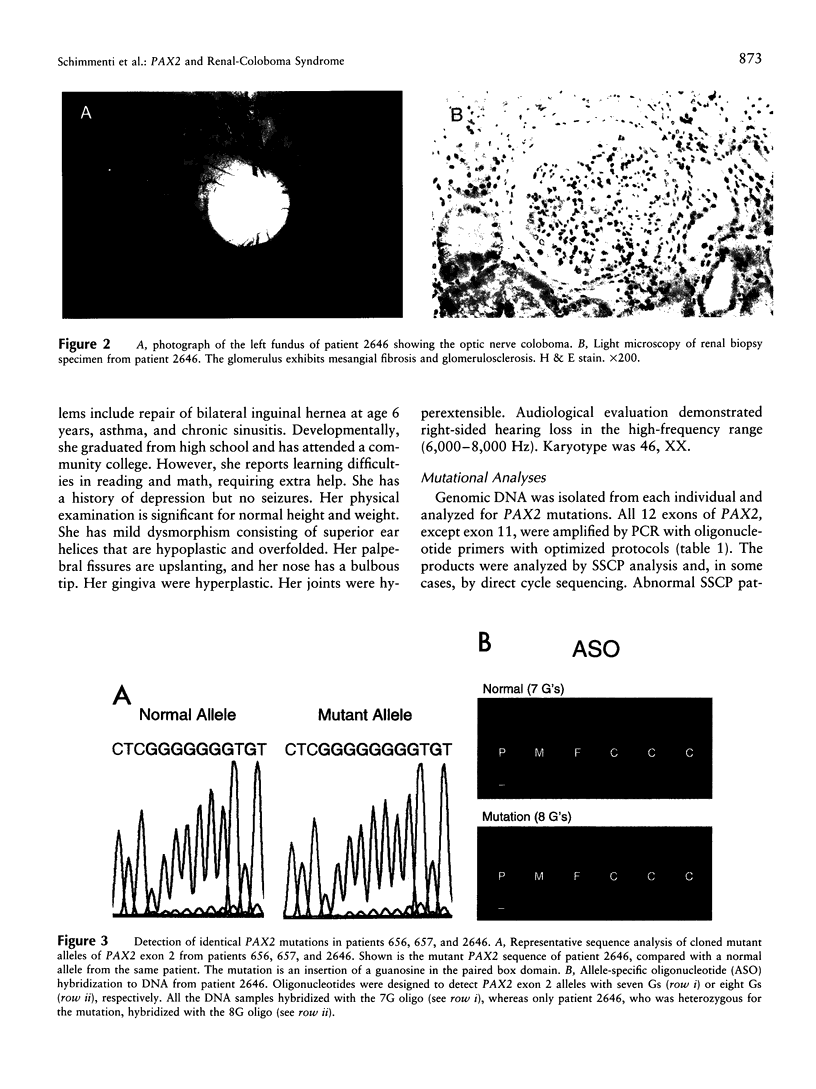
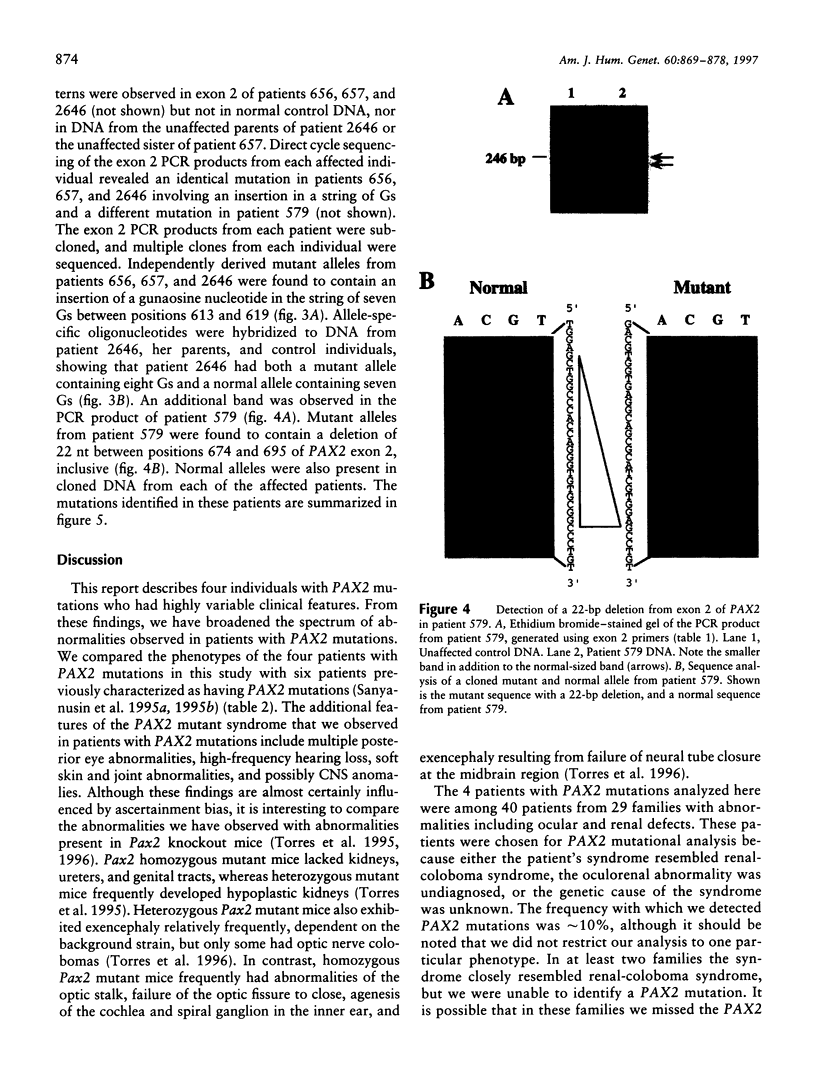
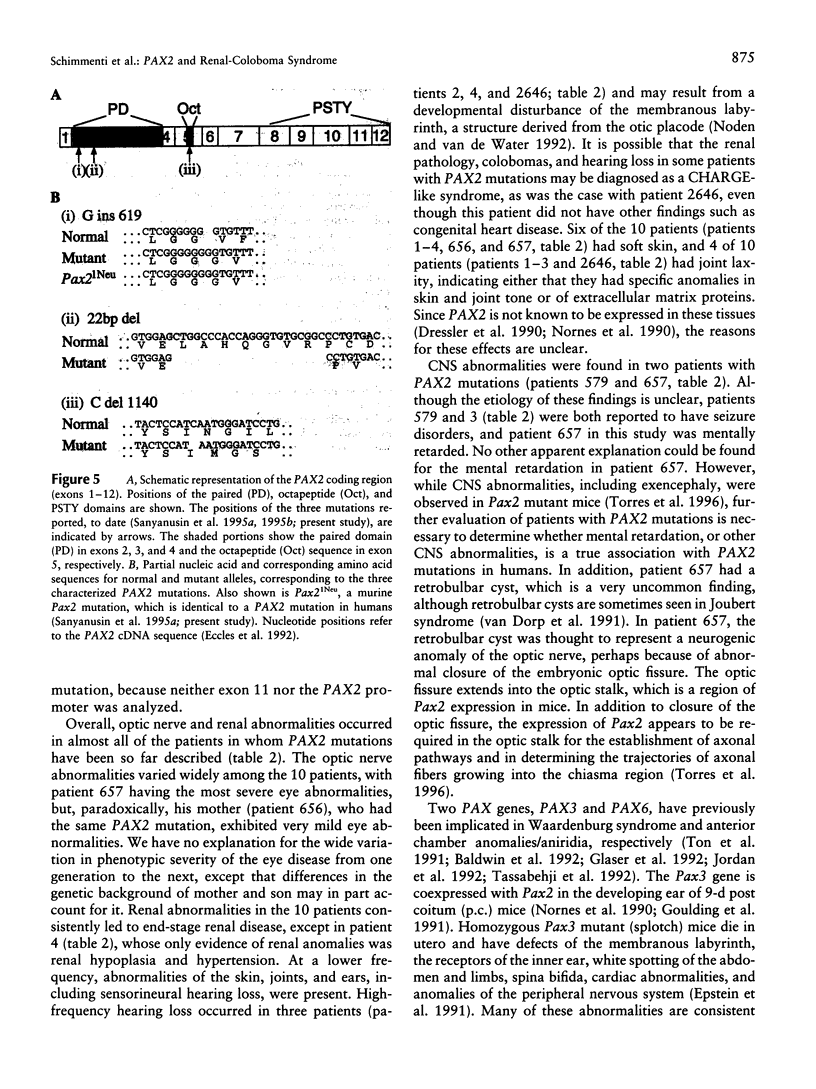
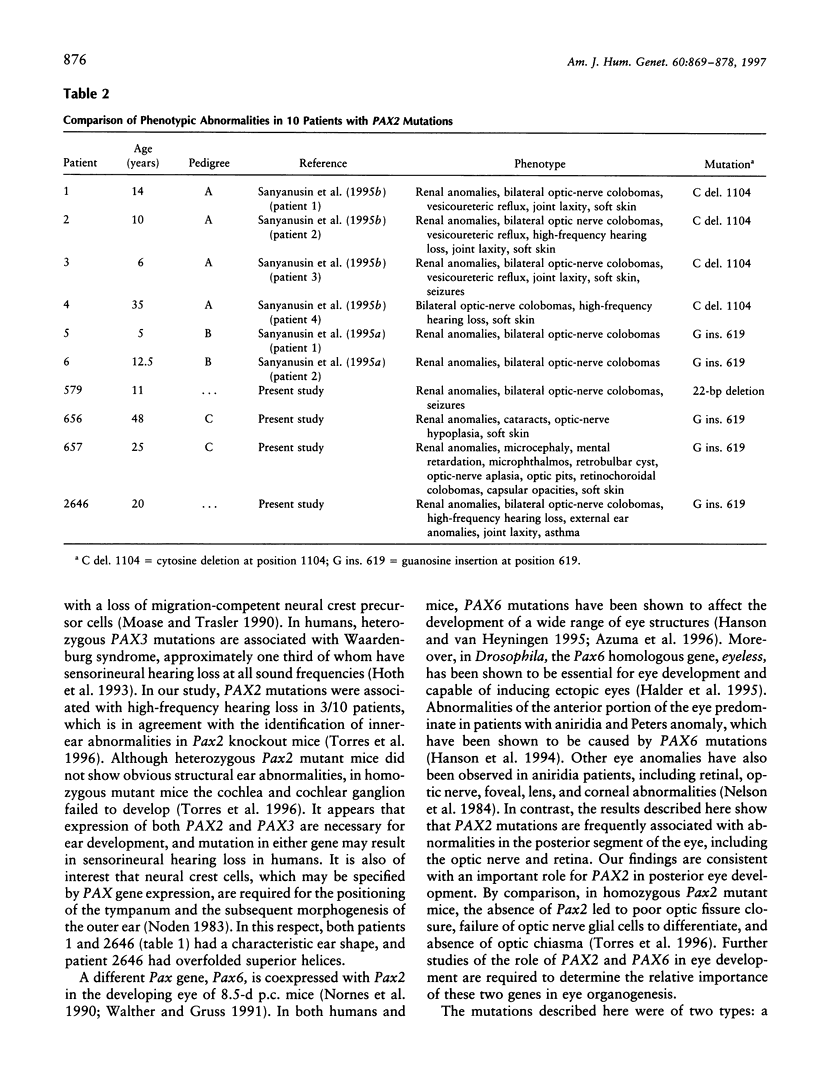
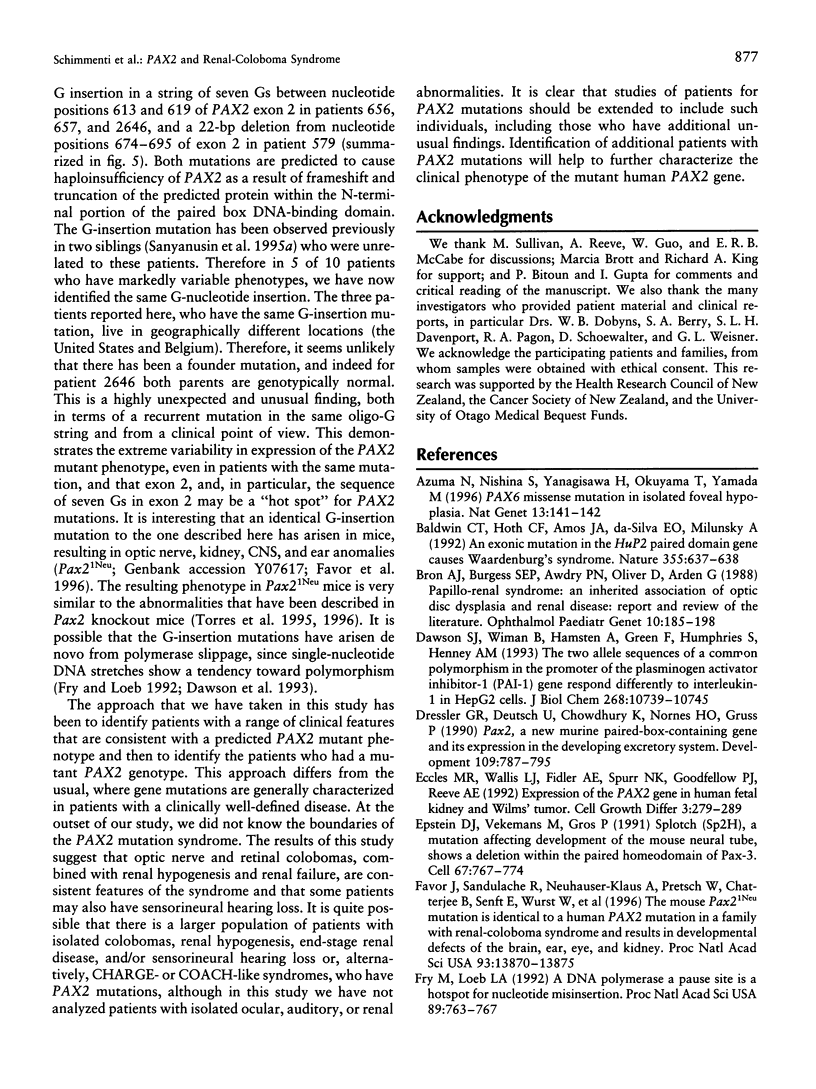
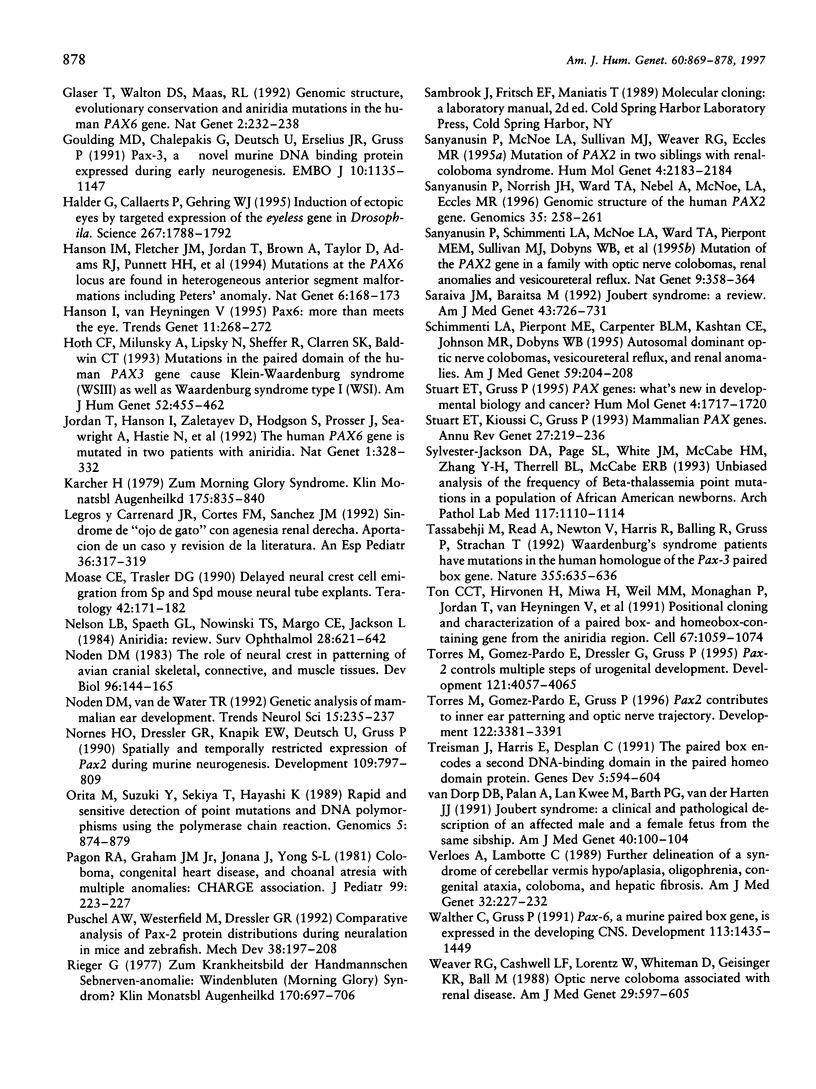
Images in this article
Selected References
These references are in PubMed. This may not be the complete list of references from this article.
- Azuma N., Nishina S., Yanagisawa H., Okuyama T., Yamada M. PAX6 missense mutation in isolated foveal hypoplasia. Nat Genet. 1996 Jun;13(2):141–142. doi: 10.1038/ng0696-141. [DOI] [PubMed] [Google Scholar]
- Baldwin C. T., Hoth C. F., Amos J. A., da-Silva E. O., Milunsky A. An exonic mutation in the HuP2 paired domain gene causes Waardenburg's syndrome. Nature. 1992 Feb 13;355(6361):637–638. doi: 10.1038/355637a0. [DOI] [PubMed] [Google Scholar]
- Bron A. J., Burgess S. E., Awdry P. N., Oliver D., Arden G. Papillo-renal syndrome. An inherited association of optic disc dysplasia and renal disease. Report and review of the literature. Ophthalmic Paediatr Genet. 1989 Sep;10(3):185–198. doi: 10.3109/13816818909009875. [DOI] [PubMed] [Google Scholar]
- Dawson S. J., Wiman B., Hamsten A., Green F., Humphries S., Henney A. M. The two allele sequences of a common polymorphism in the promoter of the plasminogen activator inhibitor-1 (PAI-1) gene respond differently to interleukin-1 in HepG2 cells. J Biol Chem. 1993 May 25;268(15):10739–10745. [PubMed] [Google Scholar]
- Dressler G. R., Deutsch U., Chowdhury K., Nornes H. O., Gruss P. Pax2, a new murine paired-box-containing gene and its expression in the developing excretory system. Development. 1990 Aug;109(4):787–795. doi: 10.1242/dev.109.4.787. [DOI] [PubMed] [Google Scholar]
- Eccles M. R., Wallis L. J., Fidler A. E., Spurr N. K., Goodfellow P. J., Reeve A. E. Expression of the PAX2 gene in human fetal kidney and Wilms' tumor. Cell Growth Differ. 1992 May;3(5):279–289. [PubMed] [Google Scholar]
- Epstein D. J., Vekemans M., Gros P. Splotch (Sp2H), a mutation affecting development of the mouse neural tube, shows a deletion within the paired homeodomain of Pax-3. Cell. 1991 Nov 15;67(4):767–774. doi: 10.1016/0092-8674(91)90071-6. [DOI] [PubMed] [Google Scholar]
- Favor J., Sandulache R., Neuhäuser-Klaus A., Pretsch W., Chatterjee B., Senft E., Wurst W., Blanquet V., Grimes P., Spörle R. The mouse Pax2(1Neu) mutation is identical to a human PAX2 mutation in a family with renal-coloboma syndrome and results in developmental defects of the brain, ear, eye, and kidney. Proc Natl Acad Sci U S A. 1996 Nov 26;93(24):13870–13875. doi: 10.1073/pnas.93.24.13870. [DOI] [PMC free article] [PubMed] [Google Scholar]
- Fry M., Loeb L. A. A DNA polymerase alpha pause site is a hot spot for nucleotide misinsertion. Proc Natl Acad Sci U S A. 1992 Jan 15;89(2):763–767. doi: 10.1073/pnas.89.2.763. [DOI] [PMC free article] [PubMed] [Google Scholar]
- Glaser T., Walton D. S., Maas R. L. Genomic structure, evolutionary conservation and aniridia mutations in the human PAX6 gene. Nat Genet. 1992 Nov;2(3):232–239. doi: 10.1038/ng1192-232. [DOI] [PubMed] [Google Scholar]
- Goulding M. D., Chalepakis G., Deutsch U., Erselius J. R., Gruss P. Pax-3, a novel murine DNA binding protein expressed during early neurogenesis. EMBO J. 1991 May;10(5):1135–1147. doi: 10.1002/j.1460-2075.1991.tb08054.x. [DOI] [PMC free article] [PubMed] [Google Scholar]
- Halder G., Callaerts P., Gehring W. J. Induction of ectopic eyes by targeted expression of the eyeless gene in Drosophila. Science. 1995 Mar 24;267(5205):1788–1792. doi: 10.1126/science.7892602. [DOI] [PubMed] [Google Scholar]
- Hanson I. M., Fletcher J. M., Jordan T., Brown A., Taylor D., Adams R. J., Punnett H. H., van Heyningen V. Mutations at the PAX6 locus are found in heterogeneous anterior segment malformations including Peters' anomaly. Nat Genet. 1994 Feb;6(2):168–173. doi: 10.1038/ng0294-168. [DOI] [PubMed] [Google Scholar]
- Hanson I., Van Heyningen V. Pax6: more than meets the eye. Trends Genet. 1995 Jul;11(7):268–272. doi: 10.1016/s0168-9525(00)89073-3. [DOI] [PubMed] [Google Scholar]
- Hoth C. F., Milunsky A., Lipsky N., Sheffer R., Clarren S. K., Baldwin C. T. Mutations in the paired domain of the human PAX3 gene cause Klein-Waardenburg syndrome (WS-III) as well as Waardenburg syndrome type I (WS-I). Am J Hum Genet. 1993 Mar;52(3):455–462. [PMC free article] [PubMed] [Google Scholar]
- Jordan T., Hanson I., Zaletayev D., Hodgson S., Prosser J., Seawright A., Hastie N., van Heyningen V. The human PAX6 gene is mutated in two patients with aniridia. Nat Genet. 1992 Aug;1(5):328–332. doi: 10.1038/ng0892-328. [DOI] [PubMed] [Google Scholar]
- Karcher H. Zum Morning Glory Syndrome. Klin Monbl Augenheilkd. 1979 Dec;175(6):835–840. [PubMed] [Google Scholar]
- Legros y Carrenard J. R., Martínez Cortés F., Martín Sánchez J. Síndrome de "ojo de gato" con agenesia renal derecha. Aportación de un caso y revisión de la literatura. An Esp Pediatr. 1992 Apr;36(4):317–319. [PubMed] [Google Scholar]
- Moase C. E., Trasler D. G. Delayed neural crest cell emigration from Sp and Spd mouse neural tube explants. Teratology. 1990 Aug;42(2):171–182. doi: 10.1002/tera.1420420208. [DOI] [PubMed] [Google Scholar]
- Nelson L. B., Spaeth G. L., Nowinski T. S., Margo C. E., Jackson L. Aniridia. A review. Surv Ophthalmol. 1984 May-Jun;28(6):621–642. doi: 10.1016/0039-6257(84)90184-x. [DOI] [PubMed] [Google Scholar]
- Noden D. M. The role of the neural crest in patterning of avian cranial skeletal, connective, and muscle tissues. Dev Biol. 1983 Mar;96(1):144–165. doi: 10.1016/0012-1606(83)90318-4. [DOI] [PubMed] [Google Scholar]
- Noden D. M., Van de Water T. R. Genetic analyses of mammalian ear development. Trends Neurosci. 1992 Jul;15(7):235–237. doi: 10.1016/0166-2236(92)90056-e. [DOI] [PubMed] [Google Scholar]
- Nornes H. O., Dressler G. R., Knapik E. W., Deutsch U., Gruss P. Spatially and temporally restricted expression of Pax2 during murine neurogenesis. Development. 1990 Aug;109(4):797–809. doi: 10.1242/dev.109.4.797. [DOI] [PubMed] [Google Scholar]
- Orita M., Suzuki Y., Sekiya T., Hayashi K. Rapid and sensitive detection of point mutations and DNA polymorphisms using the polymerase chain reaction. Genomics. 1989 Nov;5(4):874–879. doi: 10.1016/0888-7543(89)90129-8. [DOI] [PubMed] [Google Scholar]
- Pagon R. A., Graham J. M., Jr, Zonana J., Yong S. L. Coloboma, congenital heart disease, and choanal atresia with multiple anomalies: CHARGE association. J Pediatr. 1981 Aug;99(2):223–227. doi: 10.1016/s0022-3476(81)80454-4. [DOI] [PubMed] [Google Scholar]
- Püschel A. W., Westerfield M., Dressler G. R. Comparative analysis of Pax-2 protein distributions during neurulation in mice and zebrafish. Mech Dev. 1992 Sep;38(3):197–208. doi: 10.1016/0925-4773(92)90053-m. [DOI] [PubMed] [Google Scholar]
- Rieger G. Zum Krankheitsbild er Handmannschen Sehnervenanomalie "Windenblüten"-("Morning Glory"-) Syndrome? Klin Monbl Augenheilkd. 1977 May;170(5):697–706. [PubMed] [Google Scholar]
- Sanyanusin P., McNoe L. A., Sullivan M. J., Weaver R. G., Eccles M. R. Mutation of PAX2 in two siblings with renal-coloboma syndrome. Hum Mol Genet. 1995 Nov;4(11):2183–2184. doi: 10.1093/hmg/4.11.2183. [DOI] [PubMed] [Google Scholar]
- Sanyanusin P., Norrish J. H., Ward T. A., Nebel A., McNoe L. A., Eccles M. R. Genomic structure of the human PAX2 gene. Genomics. 1996 Jul 1;35(1):258–261. doi: 10.1006/geno.1996.0350. [DOI] [PubMed] [Google Scholar]
- Sanyanusin P., Schimmenti L. A., McNoe L. A., Ward T. A., Pierpont M. E., Sullivan M. J., Dobyns W. B., Eccles M. R. Mutation of the PAX2 gene in a family with optic nerve colobomas, renal anomalies and vesicoureteral reflux. Nat Genet. 1995 Apr;9(4):358–364. doi: 10.1038/ng0495-358. [DOI] [PubMed] [Google Scholar]
- Saraiva J. M., Baraitser M. Joubert syndrome: a review. Am J Med Genet. 1992 Jul 1;43(4):726–731. doi: 10.1002/ajmg.1320430415. [DOI] [PubMed] [Google Scholar]
- Schimmenti L. A., Pierpont M. E., Carpenter B. L., Kashtan C. E., Johnson M. R., Dobyns W. B. Autosomal dominant optic nerve colobomas, vesicoureteral reflux, and renal anomalies. Am J Med Genet. 1995 Nov 6;59(2):204–208. doi: 10.1002/ajmg.1320590217. [DOI] [PubMed] [Google Scholar]
- Stuart E. T., Gruss P. PAX genes: what's new in developmental biology and cancer? Hum Mol Genet. 1995;4(Spec No):1717–1720. doi: 10.1093/hmg/4.suppl_1.1717. [DOI] [PubMed] [Google Scholar]
- Sylvester-Jackson D. A., Page S. L., White J. M., McCabe H. M., Zhang Y. H., Therrell B. L., Jr, McCabe E. R. Unbiased analysis of the frequency of beta-thalassemia point mutations in a population of African-American newborns. Arch Pathol Lab Med. 1993 Nov;117(11):1110–1114. [PubMed] [Google Scholar]
- Tassabehji M., Read A. P., Newton V. E., Harris R., Balling R., Gruss P., Strachan T. Waardenburg's syndrome patients have mutations in the human homologue of the Pax-3 paired box gene. Nature. 1992 Feb 13;355(6361):635–636. doi: 10.1038/355635a0. [DOI] [PubMed] [Google Scholar]
- Ton C. C., Hirvonen H., Miwa H., Weil M. M., Monaghan P., Jordan T., van Heyningen V., Hastie N. D., Meijers-Heijboer H., Drechsler M. Positional cloning and characterization of a paired box- and homeobox-containing gene from the aniridia region. Cell. 1991 Dec 20;67(6):1059–1074. doi: 10.1016/0092-8674(91)90284-6. [DOI] [PubMed] [Google Scholar]
- Torres M., Gómez-Pardo E., Dressler G. R., Gruss P. Pax-2 controls multiple steps of urogenital development. Development. 1995 Dec;121(12):4057–4065. doi: 10.1242/dev.121.12.4057. [DOI] [PubMed] [Google Scholar]
- Torres M., Gómez-Pardo E., Gruss P. Pax2 contributes to inner ear patterning and optic nerve trajectory. Development. 1996 Nov;122(11):3381–3391. doi: 10.1242/dev.122.11.3381. [DOI] [PubMed] [Google Scholar]
- Treisman J., Harris E., Desplan C. The paired box encodes a second DNA-binding domain in the paired homeo domain protein. Genes Dev. 1991 Apr;5(4):594–604. doi: 10.1101/gad.5.4.594. [DOI] [PubMed] [Google Scholar]
- Verloes A., Lambotte C. Further delineation of a syndrome of cerebellar vermis hypo/aplasia, oligophrenia, congenital ataxia, coloboma, and hepatic fibrosis. Am J Med Genet. 1989 Feb;32(2):227–232. doi: 10.1002/ajmg.1320320217. [DOI] [PubMed] [Google Scholar]
- Walther C., Gruss P. Pax-6, a murine paired box gene, is expressed in the developing CNS. Development. 1991 Dec;113(4):1435–1449. doi: 10.1242/dev.113.4.1435. [DOI] [PubMed] [Google Scholar]
- Weaver R. G., Cashwell L. F., Lorentz W., Whiteman D., Geisinger K. R., Ball M. Optic nerve coloboma associated with renal disease. Am J Med Genet. 1988 Mar;29(3):597–605. doi: 10.1002/ajmg.1320290318. [DOI] [PubMed] [Google Scholar]
- van Dorp D. B., Palan A., Kwee M. L., Barth P. G., van der Harten J. J. Joubert syndrome: a clinical and pathological description of an affected male and a female fetus from the same sibship. Am J Med Genet. 1991 Jul 1;40(1):100–104. doi: 10.1002/ajmg.1320400121. [DOI] [PubMed] [Google Scholar]







